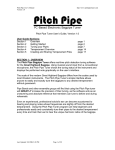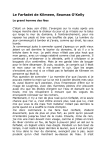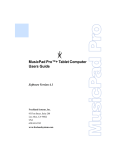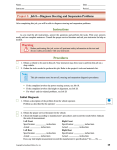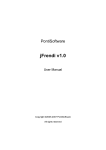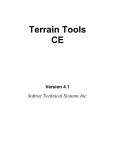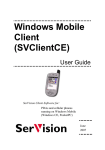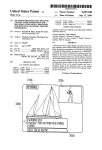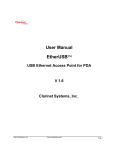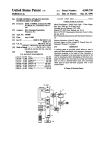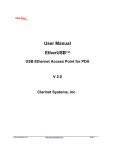Download Pitch pipe User`s Guide - Pitch Pipe Bagpipe Tuner
Transcript
Pitch Pipe PDA Version User’s Manual Version 1.0 http://www.pitchpipetuner.com Pitch Pipe Tuner for PDA User’s Guide, Version 1.0 User Guide Sections: Section 1 Overview Section 2 Getting Started Section 3 Tuning your Pipes Section 4 Temperament Overview page 1 page 1 page 3 page 8 SECTION 1 : OVERVIEW The Pitch Pipe Bagpipe Tuner for Pocket PC is real-time pitch detection tuning software for the Great Highland Bagpipe. Using musical sound input the microphone built into the PDA, the Pitch Pipe Tuner shows the tuning status of the instrument and displays the performed note graphically on the user’s interface. The scale of the modern Great Highland Bagpipe differs from the scales used by most Western instruments. The Pitch Pipe Tuner’s simple interface allows anyone to easily and exactly tune the bagpipes to any desired temperament without guesswork. Pipe Bands and other ensemble groups will find that using the Pitch Pipe tuner will GREATLY increase the precision of their tuning, as the software acts as an unwavering and absolute reference that members can tune to before and during rehearsals. Even an experienced, professional soloist’s ear can become accustomed to hearing and playing notes whose frequencies are slightly off from the desired temperament. Using the Pitch Pipe Tuner program can help beginners and professionals easily and consistently tune their pipes to the desired temperament every time and train their ear to hear the unique harmonic ratios of the bagpipe. SECTION 2 : GETTING STARTED The PDA version Pitch Pipe Bagpipe Tuner is a version of the Pitch Pipe Bagpipe tuner that has been developed for PDA's running Microsoft's Pocket PC 2002 and Pocket PC 2003 operating systems. There are separate installations for the PDA tuner depending on which version of Microsoft’s Windows Mobile operating system (Pocket PC 2002 or Pocket PC Last Updated: 11/4/2004 10:07 PM Page 1 of 10 Pitch Pipe PDA Version User’s Manual Version 1.0 http://www.pitchpipetuner.com 2003) you have installed on your PDA. If you do not know which version of Pocket PC you have installed on your PDA, click X -> Settings -> System Tab -> About. Version 4.x is 2003, version 3.x is 2002. The tuner will run for 15 days without an activation code. To install on a Pocket PC 2002 device: • You must have MS ActiveSync installed on your PC. • Download the file PPC2002_PitchPipe_setup.exe to your desktop computer, and then run the setup by double clicking on the file. • Install the Tuner into the default directory. If prompted to overwrite any files, click 'No' To install on a Pocket PC 2003 device: • You must have MS ActiveSync installed on your PC. • Download the file PPC2003_PitchPipe_setup.exe to your desktop computer, and then run the setup by double clicking on the file. • Install the Tuner into the default directory. If prompted to overwrite any files, click 'No' • NOTE : You must have the MS embedded Visual Studio runtimes installed on your PDA for the Pitch Pipe PDA tuner to function. Most PocketPC 2003 devices will not have this installed by default. If you need to install this, download and run PPC2003_MSEmbedded_Runtimes.exe on your desktop. The PDA OS will let you know if you need these runtimes the first time you try to run the Pitch Pipe PDA version tuner. • The PDA may indicate that the software was written for PPC 2002. You may dismiss this dialog if it appears. • The tuner will only conform to a portrait form layout. If you use your PDA in landscape mode, please change this prior to using the tuner. Before you start to use the tuner, it is very important to configure the microphone gain on your PDA. Most PDA's have microphone built-in that are configured to record the human voice very close the PDA. The Highland Bagpipe is quite loud, and will overload the microphone by default. To deduce the gain of your PDA's microphone, Click -> Settings -> System Tab and then look for an icon labeled ‘Audio’ or Microphone and locate the Microphone Gain control. The gain level should be as low as possible, and if you are given the option, disable AGC. It is advised to attempt to record your pipes using the 'Notes' function built into your PDA. The recording parameters should be 44.1kHz, 16bit, Mono. If the playback is very distorted, reduce the gain level and try again. If you cannot get the pipes to record cleanly, please contact us via the website for further help. Some examples of how the gain setting may look on your PDA: Last Updated: 11/4/2004 10:07 PM Page 2 of 10 Pitch Pipe PDA Version User’s Manual Version 1.0 http://www.pitchpipetuner.com Your experience with the Pitch Pipe Tuner will be even more pleasant now that you have learned a little more about how your PDA receives input from your microphone. Launch the tuner: To launch the tuner software, select the Pitch Pipe Bagpipe Tuner icon under Start -> Programs. It is recommended that you do not have any other application open, as the tuner software is CPU intensive. SECTION 3 : TUNING YOUR PIPES Setting the System Reference Pitch: For the system to accurately tune your pipes, the target reference pitch must be established. The bagpipes are unique in that there is not a consensus on what Last Updated: 11/4/2004 10:07 PM Page 3 of 10 Pitch Pipe PDA Version User’s Manual Version 1.0 http://www.pitchpipetuner.com Low A’s pitch in Hertz should be. Before starting to use the tuner, this pitch must be set. It can be set by clicking on the ‘Hz’ button on the left of the screen. The system will allow either manual entry (great for ensemble players) or automatic detection. To adjust the pitch manual, click on the arrow buttons to increase or decrease the pitch by one hertz. If the ‘Automatic’ option is selected, the system will start a timer and count down for 10 seconds. During this time, you need to start your pipes, position your chanter in front of the microphone, and blow a low A. If you are working with a friend, he/she can trigger the system by clicking on the ‘Trigger Now’ button which will capture the pitch when pressed. Clicking Apply will set the pitch and close the window. Tuning: You can set the target Hz by clicking on the Hz button on the interface, or select ‘Set Pitch’ under the Tuner menu. To switch between chanter and drones, click the ‘mode’ label on the interface, or select the ‘Set Mode’ menu item under ‘Tuner.’ Last Updated: 11/4/2004 10:07 PM Page 4 of 10 Pitch Pipe PDA Version User’s Manual Version 1.0 http://www.pitchpipetuner.com Clicking on the ‘On/Off’ button will activate the tuner. The system will display the status of each detected pitch as either flat, sharp, or in tune, as well as display the pitch in Hz on the gauge display, and in the area labeled ‘Pitch of Note.’ The closer the coloured indicators are to 0, the closer the note is to in tune. This system will also detect which note is closest to the detected pitch and display it in the area labeled ‘Detected Note.’ Please see the ‘ADJUSTING THE PITCH OF YOUR PIPES’ section below if you need help adjusting the pitch of your chanter or drones. Last Updated: 11/4/2004 10:07 PM Page 5 of 10 Pitch Pipe PDA Version User’s Manual Version 1.0 http://www.pitchpipetuner.com Please Note: Some PDA's do not have very adjustable gain settings. If the tuner sometimes reads "HiA" and "HiG" while you are playing a LoA or a LoG, you can try clicking the 'Low Hand Only' check box to assist the tuner in ignoring the harmonic distortion. ADJUSTING THE PITCH OF YOUR PIPES There are several ‘tricks of the trade’ that will be helpful to the user when attempting to adjust the pitch of the chanter. If the concept of adjusting individual notes is new to you, the following paragraph will be useful. You should also ask a local Open piper or a local Pipe Major how they adjust their instrument. The easiest way to sharpen or flatten your chanter is to simply sink or raise the reed in the chanter’s reed seat. It is important to know that changing the seating of the reed affects the high hand notes more than the low hand notes. For example, if you sink the chanter reed, the High A will sharpen more than the Low A will sharpen. Changing the reed seat is how a piper will get the chanter close to a target pitch, or how a piper will establish the pitch the chanter ‘wants’ to be at by checking the Low A and High A until they are the desired pitch without any tape. To adjust individual notes of the chanter, the size of the holes can be adjusted via tape and in extreme cases a knife. Last Updated: 11/4/2004 10:07 PM Page 6 of 10 Pitch Pipe PDA Version User’s Manual Version 1.0 http://www.pitchpipetuner.com If a note is sharp and needs to be flattened, placing tape over the hole below the note the piper is fingering will flatten the note. If the note is flat and needs to be sharpened, the reed can be sunk into the reed seat until the note is at the correct pitch, and then the other notes (which will have sharpened as well) can be flattened via tape. OR: It is not uncommon for experienced pipers to CAREFULLY carve out the holes of their chanters in order to raise the pitch of a specific note. If you have never done this before, please consult a local Open piper, a local Pipe Major, or a local Pipe Maker for instruction on how this should be done. If a piper is not a steady blower, this type of modification should never be performed. NOTE ON CARVING UP YOUR CHANTER: Pipe makers are very clever folks who have sized and placed the holes on your chanter in very exacting locations. However, blowing pressure, temperature, humidity, reed maker, etc. are also critical variables to getting the chanter in tune. While pulling out a Dremel tool, deburring tool, or a knife should never be your first method of sharpening a note, the careful customization of your chanter can make playing and staying in tune much easier. Metronome: The tuner software also comes with an accurate metronome. Last Updated: 11/4/2004 10:07 PM Page 7 of 10 Pitch Pipe PDA Version User’s Manual Version 1.0 http://www.pitchpipetuner.com SECTION 4 : UNDERSTANDING TEMPERAMENTS The scales played on the modern Great Highland Bagpipe differ from the scales used by most Western instruments. Bagpipe notes are named low G, low A, B, C, D, E, F, high G, and high A. These notes and scales do not match modern Western instruments due to slight differences in pitch and temperament. The pitch bagpipes are tuned to has been steadily rising over the years. The actual frequency of A above middle-C is 440 Hz (cycles per second). The frequency that pipers now tune low A to has risen to between 470 and 480 Hz (over a half step above A-440). This has to be taken into account when attempting to tune the bagpipes to play with other instruments. The bagpipe can produce scales that closely approximate the Mixolydian, Ionian, and Aolian modes. Many Western instruments today use “equal temperament” where each semitone or half-step of the scale is equidistant and exactly 100 cents apart. Bagpipes evolved to play unique scales with unequal ratios between each pitch. These ratios are slightly different from those used in Western modes. All of this makes it very difficult for bagpipes to play in tune with instruments that use equal temperament. Today, bagpipes are usually tuned very close to “just temperament”. Other common temperaments include the “Seumas MacNeill temperament” and “Harmonic temperament”, each with slightly different interval ratios between certain pitches. The tuner also comes with two preset temperaments that were constructed by doing advanced pitch analysis on leading soloists and pipe bands. These two presets are labeled ‘World Champion Pipe Band’ and ‘Gold Medalist’. It is interesting to note that the tuning of these temperaments is slightly different. This is due to the fact the top bands today regularly play harmonies that require some slight compromise in note tuning in order to maximize the impact of the close harmonies the bands use. Last Updated: 11/4/2004 10:07 PM Page 8 of 10 Pitch Pipe PDA Version User’s Manual Version 1.0 http://www.pitchpipetuner.com In the past, tuning the bagpipes to a desired temperament required lots of guesswork or the use of complex tuning tables that required transposition of each pitch, then tuning each note an exact number of cents sharp or flat of each equally tempered note on the tuner. The Pitch Pipe Tuner’s simple interface allows anyone to easily and exactly tune the bagpipes to any desired temperament without any guesswork or complicated tables. Users can select one of several preset temperaments. This makes it easy to set up the pipes to play with other instruments no matter what temperament the other instruments use. Understanding and creating Temperaments: The following section is from E. MacPherson’s very good research paper at: http://www-personal.umich.edu/~emacpher/pipes/acoustics/pipescale.html We were going to write our own description, but Ewan’s is so clear! From the time of Pythogoras, it has been known that two notes sounding together are heard as a consonance (a smooth, pleasant combination) when the ratio of their frequencies is a fraction with small integers in the numerator and denominator. In such a situation the two notes have many harmonics in common, which reduces the roughness of the combination. A simple example is the octave (from low A to high A) in which the frequency ratio is 2:1 and every harmonic of the upper note coincides with a harmonic of the lower one. A ratio of 5:4 gives a major 3rd (A to C#), and a perfect 5th (A to E) has a ratio of 3:2. In solo pipe music the frequency ratio we are concerned with is always that between the chanter and the drones. Since the drone notes are "A" (one or two octaves below the chanter's low A) we can just define the frequency of each note on the chanter by the ratio of its frequency to that of low A. Thus for example, low A will have a ratio of 1:1, and high A will have a ratio of 2:1. Not all of the frequency ratios on the chanter are universally agreed-upon, and tuning styles, like the overall pitch, have changed with time. Some notes (the As, C, and E for example) are very easy to set relative to the drones, with clearly audible "beating" when out of tune, but others are less straightforward. In particular there are several schools of thought on the tuning of D and high G. In the non-piping world, the simplest and purest tuning scheme known for a Mixolydian scale is a type of Just Intonation (which simply means a scale using whole-number frequency ratios) in which D is tuned to a frequency ratio of 4:3 above low A, and the high G is tuned to a ratio of 16:9. However, in 1954, J. Lenihan and Seumas MacNeill published a study of the tuning of 18 pipe Last Updated: 11/4/2004 10:07 PM Page 9 of 10 Pitch Pipe PDA Version User’s Manual Version 1.0 http://www.pitchpipetuner.com chanters in which they concluded that Ds were tuned to 27:20, and the high G to 9:5. These values are sharper than the simple Just values, although since they are whole-number ratios they are, strictly speaking, just. A scale formed in this way has unique and interesting melodic properties, particularly when one considers the various pentatonic scales which can be derived from it (Piping Times, October 1997). Analyses of recent recordings by well-known soloists from North America and the U.K. show that tuning practice has changed in the last 4 decades. Ds vary from piper to piper, but are generally tuned very close to the Just D (a 4:3 ratio with low A) rather than the significantly sharper 27:20 ratio. High Gs are also tuned much flatter, apparently at a ratio of 7:4, which might be termed the "Harmonic" high G since in this case the note's harmonics coincide exactly with every 7th harmonic of the bass drone. Low Gs are frequently exactly an octave lower at 7:8. In practice, the tuning of high A almost always departs from a true octave relationship with the drones, and is typically tuned 10 to 30 cents flat. Recordings of John D. Burgess provide good example of this effect. It is perhaps done in order to make the high A more audible against the drones or to guard against the reed sharpening up during a performance, but is probably best regarded as a matter of convention or taste. Certainly the ear of the pipe music aficionado becomes used to the flat high A to such an extent that a "true", octave high A can sound overly sharp and shrill. End MacPherson Thank you for your interest in the Pitch Pipe Bagpipe Tuner. If you have additional questions, or comments on how this user’s guide to be made better, please let us know! Visit us on the web! http://www.pitchpipetuner.com Last Updated: 11/4/2004 10:07 PM Page 10 of 10










